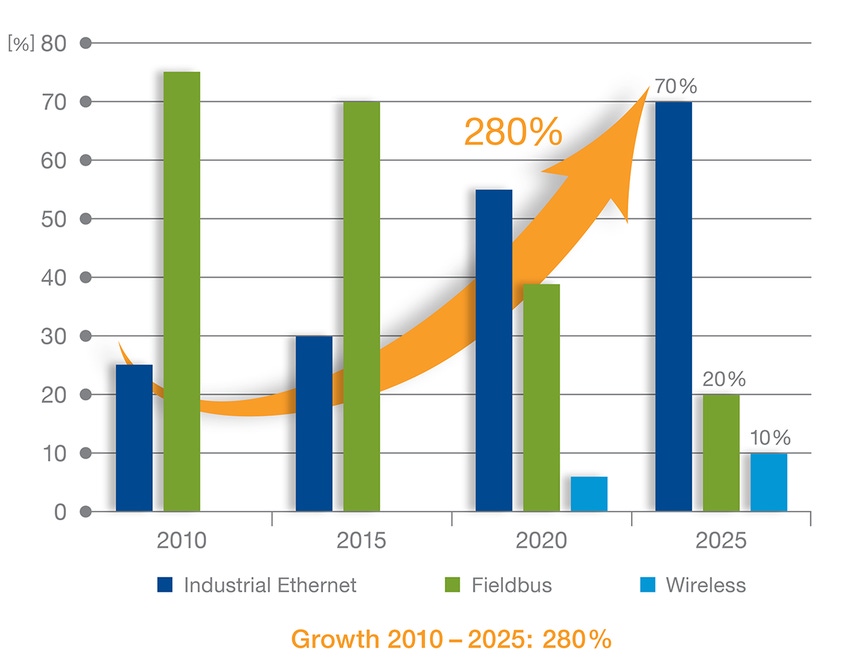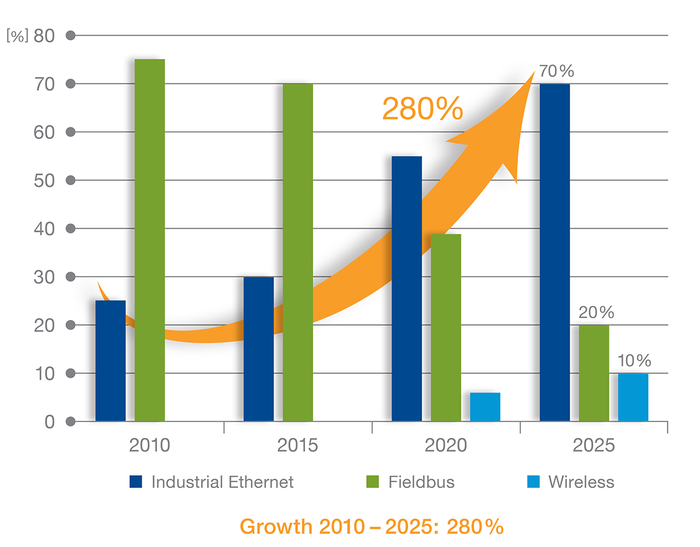Single Pair Ethernet Technology Megatrend
Single Pair Ethernet technology that works with IEEE 802.3 extending from sensors to the cloud is moving toward worldwide and widespread adoption.
August 6, 2019

Industrial Ethernet communications technology is continuing to morph and adapt to the demands of a future Internet of Things (IoT) world with the ongoing development of Single Pair Ethernet (SPE) and IEEE 802.3cg standards. Developments within the automotive industry are identified as a key driver of the technology with the use of Ethernet for vehicle cameras, diagnostics and security expanding into potential solutions for driverless technology.
|
The expected growth rate of Industrial Ethernet from 2010 to 2025 is projected to be 280%. (Image source: Belden) |
IEE 802.3 Ethernet Standards
The goal of new SPE technology is to connect devices at 10 Megabits per second over up to at least 1,000 meters, and offer the option of Power over Data Lines technology (PoDL) for remote power that would be especially useful in hazardous environments.
According to a new Belden white paper, Single Pair Ethernet (SPE) technology together with Time Sensitive Networking (TSN), offers a new, unique SPE protocol for encoding and scrambling data, enabling industrial and process networks to achieve lower electromagnetic interference (EMI), lower cost, reduced cabling weight, and higher bandwidth.
“One lighter, thinner cable that is still capable of Power over Data Lines (PoDL) and that will have a signal and power reach up to 1000 meters is arriving now. This will be one cable and one network type that any sensor or actuator can get power from, and any sensor or actuator can talk to,” the report stated.
Another key advantage of the move to single twisted pair is that is offers an ability to reuse existing cables, and especially Foundation H1, HART, PROFIBUS PA and 4-20mA connections. Benefits include an enormous installed base of Single Twisted Pair, usually shielded and sometimes certified, in the field. Lengthy fieldbus cables are expensive to install (often in filled conduit) and end nodes would be easier to replace.
Advanced Physical Layer
Related work is ongoing to create an Advanced Physical Layer (APL) for Ethernet that can be used in process automation and instrumentation to connect field devices in remote and hazardous locations. Cooperative work between industrial standards development organizations including ODVA, the FieldComm Group and Profibus and Profinet International (PI) is focused on a goal to ensure that all technologies and standards will be compatible with their respective protocols (EtherNet/IP, HART-IP and PROFINET).
APL is a ruggedized, two-wire, loop-powered Ethernet physical layer a910BASE-T1L with extensions for hazardous areas. The technology is intended to enable direct connection of field devices to Ethernet-based systems utilizing a switched architecture that eliminate unwanted interference between devices connected to the same network.
New IEC Cable Standards
New cabling standards, including IEC 61156-13 and IEC 61156-14, are another area that is under active development. New standards are intended to describe symmetrical single pair cables with transmission characteristics up to 20 MHz over a distance up to 1 kilometer (km) to support 10Mbps for mainly industrial applications.
Belden affirmed that these cable types “are intended to be used for shielded channels, and may also support remote powering. Part 13 can be used for horizontal floor wiring, thus the specification for it to have a solid, annealed copper conductor, and a nominal diameter between 0.64 and 1.7 mm. Part 14 is intended for work area wiring and stranded wire, so it is in flexible materials.”
SPE Technology Partnerships
TE Connectivity (TE) and HARTING have also announced a technology infrastructure partnership to set Single Pair Ethernet as its de facto infrastructure solution to enable IIoT applications.
RELATED ARTICLES:
The current expectation is that 802.3cg 10Base-T1, for distances up to 1 km, will be released later in 2019. The overall timeline for SPE technology is that there will be a continual move beyond 2020 toward rapid growth and deployment of Industrial Ethernet networks incorporating new breed of native Industrial Ethernet smart devices.
Al Presher is a veteran contributing writer for Design News, covering automation and control, motion control, power transmission, robotics, and fluid power.
Drive World with ESC Launches in Silicon Valley This summer (August 27-29), Drive World Conference & Expo launches in Silicon Valley with North America's largest embedded systems event, Embedded Systems Conference (ESC). The inaugural three-day showcase brings together the brightest minds across the automotive electronics and embedded systems industries who are looking to shape the technology of tomorrow. |
About the Author(s)
You May Also Like


.jpg?width=300&auto=webp&quality=80&disable=upscale)


